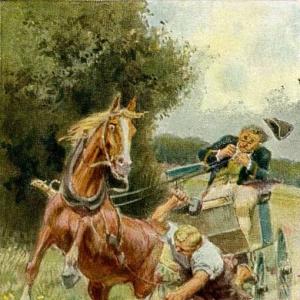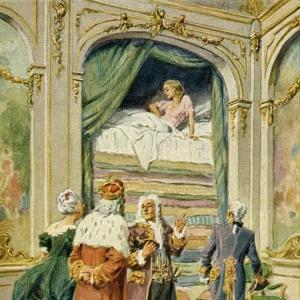Reading time: 10 min
The largest green leaf in this country is certainly the burdock-leaf. If you hold it in front of you, it is large enough for an apron; and if you hold it over your head, it is almost as good as an umbrella, it is so wonderfully large. A burdock never grows alone; where it grows, there are many more, and it is a splendid sight; and all this splendor is good for snails. The great white snails, which grand people in olden times used to have made into fricassees; and when they had eaten them, they would say, „O, what a delicious dish!“ for these people really thought them good; and these snails lived on burdock-leaves, and for them the burdock was planted.
There was once an old estate where no one now lived to require snails; indeed, the owners had all died out, but the burdock still flourished. It grew over all the beds and walks of the garden– its growth had no check– till it became at last quite a forest of burdocks. Here and there stood an apple or a plum-tree; but for this, nobody would have thought the place had ever been a garden. It was burdock from one end to the other; and here lived the last two surviving snails.
They knew not themselves how old they were; but they could remember the time when there were a great many more of them, and that they were descended from a family which came from foreign lands, and that the whole forest had been planted for them and theirs. They had never been away from the garden; but they knew that another place once existed in the world, called the Duke’s Palace Castle, in which some of their relations had been boiled till they became black, and were then laid on a silver dish; but what was done afterwards they did not know. Besides, they could not imagine exactly how it felt to be boiled and placed on a silver dish; but no doubt it was something very fine and highly genteel. Neither the cockchafer, nor the toad, nor the earth-worm, whom they questioned about it, would give them the least information. For none of their relations had ever been cooked or served on a silver dish.
The old white snails were the most aristocratic race in the world,– they knew that. The forest had been planted for them, and the nobleman’s castle had been built entirely that they might be cooked and laid on silver dishes.
They lived quite retired and very happily; and as they had no children of their own, they had adopted a little common snail, which they brought up as their own child. The little one would not grow, for he was only a common snail; but the old people, particularly the mother-snail, declared that she could easily see how he grew; and when the father said he could not perceive it, she begged him to feel the little snail’s shell, and he did so, and found that the mother was right.
One day it rained very fast.
„Listen, what a drumming there is on the burdock-leaves; turn, turn, turn; turn, turn, turn,“ said the father-snail.
„There come the drops,“ said the mother; „they are trickling down the stalks. We shall have it very wet here presently. I am very glad we have such good houses, and that the little one has one of his own. There has been really more done for us than for any other creature. It is quite plain that we are the most noble people in the world. We have houses from our birth, and the burdock forest has been planted for us. I should very much like to know how far it extends, and what lies beyond it.“
„There can be nothing better than we have here,“ said the father-snail; „I wish for nothing more.“
„Yes, but I do,“ said the mother; „I should like to be taken to the palace, and boiled, and laid upon a silver dish, as was done to all our ancestors; and you may be sure it must be something very uncommon.“
„The nobleman’s castle, perhaps, has fallen to decay,“ said the snail-father, „or the burdock wood may have grown out. You need not be in a hurry. You are always so impatient, and the youngster is getting just the same. He has been three days creeping to the top of that stalk. I feel quite giddy when I look at him.“
„You must not scold him,“ said the mother-snail; „he creeps so very carefully. He will be the joy of our home; and we old folks have nothing else to live for. But have you ever thought where we are to get a wife for him? Do you think that farther out in the wood there may be others of our race?“
„There may be black snails, no doubt,“ said the old snail; „black snails without houses; but they are so vulgar and conceited too. But we can give the ants a commission. They run here and there, as if they all had so much business to get through. They, most likely, will know of a wife for our youngster.“
„I certainly know a most beautiful bride,“ said one of the ants. „But I fear it would not do, for she is a queen.“
„That does not matter,“ said the old snail; „has she a house?“
„She has a palace,“ replied the ant,– „a most beautiful ant-palace with seven hundred passages.“
„Thank-you,“ said the mother-snail. „But our boy shall not go to live in an ant-hill. If you know of nothing better, we will give the commission to the white gnats. They fly about in rain and sunshine. They know the burdock wood from one end to the other.“
„We have a wife for him,“ said the gnats; „a hundred man-steps from here there is a little snail with a house, sitting on a gooseberry-bush. She is quite alone, and old enough to be married. It is only a hundred man-steps from here.“
„Then let her come to him,“ said the old people. „He has the whole burdock forest. She has only a bush.“
So they brought the little lady-snail. She took eight days to perform the journey; but that was just as it ought to be. For it showed her to be one of the right breeding.
And then they had a wedding. Six glow-worms gave as much light as they could; but in other respects it was all very quiet. For the old snails could not bear festivities or a crowd. But a beautiful speech was made by the mother-snail. The father could not speak. He was too much overcome. Then they gave the whole burdock forest to the young snails as an inheritance, and repeated what they had so often said, that it was the finest place in the world, and that if they led upright and honorable lives, and their family increased, they and their children might some day be taken to the nobleman’s palace, to be boiled black, and laid on a silver dish.
And when they had finished speaking, the old couple crept into their houses, and came out no more. For they slept. The young snail pair now ruled in the forest, and had a numerous progeny. But as the young ones were never boiled or laid in silver dishes, they concluded that the castle had fallen into decay, and that all the people in the world were dead; and as nobody contradicted them, they thought they must be right. And the rain fell upon the burdock-leaves, to play the drum for them, and the sun shone to paint colors on the burdock forest for them, and they were very happy. The whole family were entirely and perfectly happy.
 Learn languages. Double-tap on a word.Learn languages in context with Childstories.org and Deepl.com.
Learn languages. Double-tap on a word.Learn languages in context with Childstories.org and Deepl.com.Backgrounds
Interpretations
Adaptions
Summary
Linguistics
„The Happy Family“ is a fairy tale by Danish author Hans Christian Andersen, who is well-known for his vast collection of fairy tales and children’s stories, such as „The Little Mermaid,“ „The Ugly Duckling,“ and „The Emperor’s New Clothes.“ Andersen published this story in 1852 as part of his collection „New Fairy Tales. First Volume. Third Collection“ (Nye Eventyr. Første Bind. Tredie Samling). Born in 1805, Andersen’s stories have become classic tales that have been adapted into various forms of media, including film, television, and stage productions.
Hans Christian Andersen’s tales often touch on universal themes, such as the value of kindness, the importance of family, and the search for personal identity. „The Happy Family“ reflects these themes, as well as the Romantic movement’s appreciation of nature and simplicity, which was popular during Andersen’s time.
The story is set in a burdock forest that once belonged to a grand estate, showing the contrast between the opulent past and the simplicity of nature that has since taken over. The tale revolves around a family of white snails who believe themselves to be of noble origin, illustrating the idea that happiness and contentment can be found in a simple life connected to nature, rather than seeking social status or material wealth.
„The Happy Family“ is an example of Andersen’s storytelling prowess, highlighting his ability to combine elements of fantasy and reality to create timeless stories that resonate with readers across generations.
„The Happy Family“ by Hans Christian Andersen can be interpreted in several ways. Here are a few key themes and messages:
Contentment vs. Ambition: The story presents a contrast between contentment with one’s life and the desire for something more. The mother-snail yearns for the prestige of being served in the nobleman’s palace, while the father-snail is content with their simple life in the burdock forest. In the end, the young snail couple and their children lead peaceful and happy lives without experiencing the prestige of their ancestors.
Nature and Simplicity: The burdock forest serves as a peaceful and idyllic setting, providing the snails with everything they need. The story suggests that happiness can be found in simplicity and living in harmony with nature, rather than seeking material wealth or social status.
Family and Tradition: The story emphasizes the importance of family and passing on traditions from one generation to the next. The snails believe in the importance of maintaining their aristocratic heritage, even though the reasons behind these traditions are no longer relevant to their lives. The old snails pass on their burdock forest and wisdom to the young snail couple, ensuring the continuity of their family line.
The Passage of Time: The story reflects on the passage of time and the inevitability of change. The once grand estate is now overtaken by burdock plants, the nobleman’s palace is no longer relevant, and the old snails eventually pass away. Through these changes, the snail family continues to thrive and find happiness in their simple lives.
The Unreliability of Stories: The snails‘ beliefs about their noble origins and the grandeur of the palace are based on stories passed down through generations. Their assumptions about the world outside their burdock forest may not be entirely accurate, illustrating how stories can be distorted or misunderstood over time.
There have been several adaptations of Hans Christian Andersen’s fairy tale, „The Happy Family“, over the years. Here are a few notable examples.
Animated film: In 1959, a Soviet animated film titled „The Happy Family“ was released. The film closely follows Andersen’s original story and features beautiful animation and a charming score.
Children’s book: In 2015, a children’s book titled „The Happy Family“ was published by Nosy Crow. The book features illustrations by British artist Emily Sutton and is a modern retelling of Andersen’s story.
Puppet show: In 2016, the Puppet Theater Bremen in Germany created a puppet show adaptation of „The Happy Family“. The show uses beautifully crafted puppets to bring the story to life and has received rave reviews from audiences.
Musical play: In 2019, a musical play titled „The Happy Family“ premiered in Singapore. The play is a modern retelling of Andersen’s story and features original music and lyrics.
Audio drama: In 2020, an audio drama adaptation of „The Happy Family“ was released by The Hans Christian Andersen Center at the University of Southern Denmark. The drama is a faithful adaptation of Andersen’s story and features voice acting by professional actors.
Overall, „The Happy Family“ has inspired many adaptations over the years, each bringing its own unique interpretation and vision to Andersen’s classic tale.
„The Happy Family“ by Hans Christian Andersen tells the story of the last two surviving white snails who live in a burdock forest that once belonged to a grand estate. These snails believe they come from a noble and aristocratic family, as their ancestors were once cooked and served on silver dishes in a nobleman’s palace. They live a retired and peaceful life, adopting a common snail and raising it as their own child.
The mother-snail dreams of experiencing the same honor their ancestors had – being taken to the palace, boiled, and laid on a silver dish. The father-snail, however, is content with their current life. The mother-snail also worries about finding a suitable wife for their adopted child. They ask the ants and white gnats for help, eventually learning of a little lady-snail living on a gooseberry bush, a hundred man-steps away.
After a long journey, the lady-snail arrives, and they hold a modest wedding with glow-worms providing light. The old snails give the entire burdock forest to the young snail couple as an inheritance and advise them to lead honorable lives, hoping that they too may someday be taken to the palace. The old snails then retreat into their shells, never to emerge again.
The young snails rule the forest and have numerous children, but they are never taken to the palace as their ancestors were. They assume that the castle has fallen into disrepair and that all humans have died. Rain falls on the burdock leaves, creating a natural drumming sound, while the sun illuminates their beautiful forest. The entire snail family is happy, living in perfect harmony and contentment.
Hans Christian Andersen’s „The Happy Family“ is a poignant fairy tale that utilizes linguistic elements to convey themes of aristocracy, ignorance, and contentment. Below, I’ll provide a linguistic analysis of the text, focusing on some of its prominent features:
Narrative Voice and Style
Narrative Perspective: The story is told from a third-person perspective, which allows for a bird’s-eye view of the snail family’s life and their quaint worldview. The narrator employs a tone that blends whimsy with irony, subtly critiquing the snails’ misperceptions.
Descriptive Language: Andersen uses rich descriptive language to paint the setting. Phrases like „a forest of burdocks“ and „the largest green leaf“ evoke a vivid image of the snails’ environment. The detailed descriptions emphasize the snails’ provincial view of their world as immense and all-encompassing.
Themes and Symbolism
Aristocracy and Social Class: Language associated with nobility pervades the text. Words like „nobleman’s castle,“ „silver dish,“ and „most aristocratic race“ underscore the snails’ misplaced belief in their aristocratic status, a satirical comment on human social stratification.
Ignorance and Contentment: The snails‘ ignorance is portrayed through their misconceptions and lack of awareness beyond their immediate world. The dialogue is crafted to emphasize their limited understanding. For instance, the old snails‘ belief that the burdock forest was planted for them humorously reflects their narrow-mindedness.
Character Dialogue and Development
Dialogue: Andersen uses simple yet expressive dialogue to characterize the snails. The mother-snail’s assertive declarations and the father-snail’s more complacent responses illustrate a dynamic that is both endearing and comically misguided.
Character Motivation: The snails‘ desire for their offspring to be „boiled and laid on a silver dish“ underscores their romanticized view of their ancestors‘ fate, highlighting their detachment from reality. This aspiration drives much of the narrative and is expressed in their dialogue.
Irony and Satire
Situational Irony: The story is steeped in irony. The snails consider themselves noble despite living common lives in an overgrown garden. Their belief in the burdock’s grandeur versus its actual mundanity is a comment on human tendencies to aggrandize one’s position.
Satirical Elements: Andersen’s tale satirizes the notion of social superiority. The snails‘ pride in their „houses“ upon birth and their distorted view of being „served on a silver dish“ satirize the vanity and unfounded pride of the nobility.
Conclusion
The linguistic elements of „The Happy Family“ enhance the thematic depth of the tale. Through vivid imagery, ironic dialogue, and a focus on social status, Andersen crafts a narrative that critiques human folly and celebrates simple contentment. The snails‘ story ultimately reflects on the nature of happiness and the ironies inherent in societal values.
Information for scientific analysis
Fairy tale statistics | Value |
|---|---|
| Translations | DE, EN, DA, ES, FR, IT, NL |
| Readability Index by Björnsson | 27.8 |
| Flesch-Reading-Ease Index | 82.2 |
| Flesch–Kincaid Grade-Level | 6.3 |
| Gunning Fog Index | 9.2 |
| Coleman–Liau Index | 8 |
| SMOG Index | 8.6 |
| Automated Readability Index | 6.7 |
| Character Count | 7.020 |
| Letter Count | 5.375 |
| Sentence Count | 73 |
| Word Count | 1.328 |
| Average Words per Sentence | 18,19 |
| Words with more than 6 letters | 127 |
| Percentage of long words | 9.6% |
| Number of Syllables | 1.667 |
| Average Syllables per Word | 1,26 |
| Words with three Syllables | 63 |
| Percentage Words with three Syllables | 4.7% |

 Facebook
Facebook  Whatsapp
Whatsapp  Messenger
Messenger  Telegram
Telegram Reddit
Reddit














